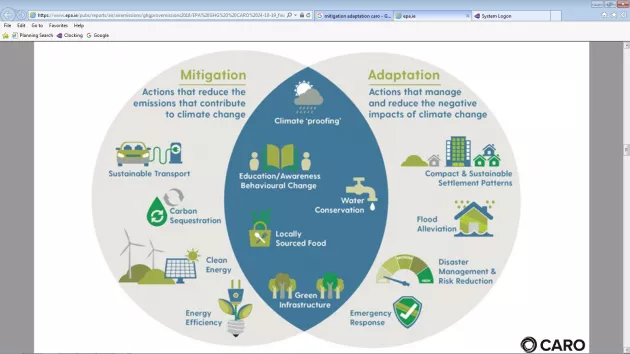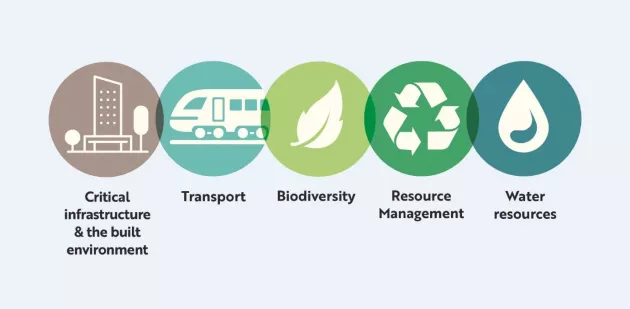3.1 - Introduction
3.1 - Introduction
Background
Climate change is one of the most pressing global challenges facing this, and future generations.
Climate change can be defined as the alterations to climate directly or indirectly attributed to human activities, which release greenhouse gases into the atmosphere.
Greenhouse gases (GHGs), namely carbon dioxide (CO2), methane (CH4) and nitrogen oxide (NOx), accumulate and prevent heat energy from leaving the Earth, resulting in what is referred to as the greenhouse effect.
While global mean temperatures caused by GHG emissions have been increasing since the industrial revolution, the rate at which temperatures are increasing has doubled since the mid-1980s and, in 2018, the accumulation of greenhouse gases was at a new record high of 457 parts per million (ppm) CO2 equivalent (compared with 330 ppm in 1970 and 286 ppm in 1870).
The expression of increased concentrations of GHGs is experienced as changes in average weather or climate change impacts. These include: extreme weather events; sea level rise; flooding; coastal erosion; drought; increased rainfall; and extreme temperatures. None of these events occurs in isolation, but rather as compound events with cascading impacts that have direct and indirect impacts on the environment, society and the economy.
If we continue to do nothing, levels of atmospheric carbon dioxide will continue to increase, average temperatures will continue to rise and the climate will become more volatile.
Climate Change and Dublin City
As acknowledged in the Dublin City Council Climate Action Plan (CCAP) (2019-2024), the effects of climate change are already impacting Dublin City at a significant rate and are very likely to increase in their frequency and intensity.
For example, the average sea level in Dublin Bay has risen by nearly twice the global average. In the last 20 years, the number of days with heavy rainfall has also increased as have the amount of extreme flooding events in Dublin in the last 10 years.
Dublin City has also experienced temperature extremes, such as in 2018 when Met Éireann issued its first ever Status Red warning for snow in February, followed by one of the hottest summers on record during June and July of the same year.
With over 15% of the country’s population living within Dublin City Council’s administrative area, the council will be active in influencing and enabling the changes to allow for the city to play its role in transitioning to a low-carbon society in a just and equitable way.
Reducing greenhouse gas emissions and building climate resilience can also create co-benefits including cleaner air, health benefits and more energy efficient buildings. This in turn will have positive benefits for residents, businesses and visitors alike. There are also economic opportunities to be realised in tackling climate change through innovative and technological solutions such as renewable energy, sensor technologies and ‘Smart City’ solutions such as those being trialled by Smart Dublin.
Mitigation and Adaptation
Climate change can be addressed by two primary complementary responses, namely, mitigation and adaptation. As defined by the United Nations Intergovernmental Panel on Climate Change (UN IPCC):
- mitigation is a human intervention to reduce the sources, or enhance the sinks of greenhouse gases; and
adaptation is the process of adjustment to actual or expected climate and its effects. In human systems, adaptation seeks to moderate or avoid harm or exploit beneficial opportunities. In some natural systems, human intervention may facilitate adjustment to expected climate and its effects
Figure 3 1: Examples of Climate Mitigation and Adaptation Measures

Source: Eastern and Midlands CARO
As the examples shown in Figure 3-1 above suggest, mitigation addresses the causes of climate change, whereas adaptation addresses the impacts of climate change.
While historically, priority has been given to mitigation measures, it is now recognised that adaptation is just as important as mitigation, and both actions taken in conjunction are crucial to limiting the impacts of climate change.
International, National and Local Climate Policy
In recent years, a succession of policies and actions have been developed at global, European, national, regional and local levels to address climate change, with an increasing focus on the decarbonisation of society.
At a European level, the 2030 Climate and Energy Framework, the European Green Deal and the EU Biodiversity Strategy to 2030 provide an overall framework for climate action in EU member states. The main aim of the European Green Deal is to be climate-neutral by 2050, which means an economy where there is a net-zero balance between GHG emission sources and sinks. To ensure the right trajectory, the Fit for 55 Plan sets out how the EU will achieve a reduction in carbon emissions by 55% compared with 1990 levels by 2030.
Nationally, a climate and biodiversity emergency was declared by Dáil Éireann and Dublin City Council in 2019. Subsequently, the government’s 2021 Climate Action Plan (CAP) provides a detailed framework which identified how Ireland will achieve a 51% reduction in Ireland's overall GHG emissions from 2021 to 2030, and to achieving net-zero emissions no later than 2050. These legally-binding objectives are set out in the Climate Action and Low Carbon Development (Amendment) Act 2021. The CAP commits to delivering a just transition, recognising the significant level of change required and that the burden must be as fairly distributed as possible.
In addition, under the National Adaptation Framework, twelve Sectoral Adaptation Plans were published by various government departments in 2019, setting out key risks faced across the different sectors and the approach being taken to address these risks and build climate resilience for the future.
At the city level, the Dublin City Climate Change Action Plan, 2019-2024 (CCAP) demonstrates Dublin City Council’s commitment to transitioning to a low carbon society and economy.
The CCAP, which is reviewed quarterly and reported on annually, sets out four key targets and over 200 actions that the council is undertaking in the areas of energy and buildings, transport, flood resilience, nature-based solutions and resource management.
Figure 3 2: Action Areas identified in the Dublin City Climate Action Plan

The Climate Action Plan for Dublin City Council sets a target of 40% reduction in the Council’s greenhouse gas emissions by 2030. As a signatory to the Covenant of Mayors Dublin City has a more ambitious target of 55% by 2030 and carbon neutrality by 2050, in line with the EU Green Deal ambitions. The CCAP is a key element of the council’s strategic approach to climate action and has informed and guided the policies and objectives contained in this development plan.
Spatial Planning and Reducing Carbon Emissions
In spatial planning policy terms, both the National Planning Framework (NPF) and the Eastern and Midland Regional Assembly’s Regional Spatial and Economic Strategy (RSES) set out the role of the city development plan in relation to climate action.
The NPF’s National Strategic Outcome (NSO) No. 8 ‘To Transition to a Low Carbon and Climate Resilient Society’ establishes a national objective to transition to a competitive, low carbon economy by the year 2050 and National Policy Objective (NPO) 54 seeks to “reduce our carbon footprint by integrating climate action into the planning system in support of national targets for climate policy mitigation and adaptation objectives, as well as targets for greenhouse gas emission reductions”.
At the regional level, a key element of the RSES’s climate strategy is the need to monitor progress towards achieving national commitment to reduce GHG emissions by 40% to 2030, and to support a transition to a low carbon society by 2050. EMRA is to establish a regional GHG emissions inventory and agree reduction targets in accordance with national plans.
In accordance with Regional Policy Objective (RPO 3.6) of the RSES, Dublin City Council will need to assess the impact of the development plan on carbon reduction targets, and to develop appropriate mechanisms to monitor greenhouse gas emissions in order to be in a position to fully measure progress against key milestones demonstrating carbon reduction over the coming years.
As outlined in the RSES, this exercise will be dependent on the publication of guidelines, prepared by the Department of Housing, Local Government and Heritage (DHLGH) which will provide clarification around the development of a suitable methodology for measuring carbon emissions appropriate to strategic land use designation and related transport infrastructure in the context of the preparation of city/county development plans.
In view of the changing context in respect of climate action policy at national level, Dublin City Council will consider a variation of the development plan within a reasonable period of time to ensure the development plan will be will be consistent with the approach to climate action recommended in any relevant guidelines issued by the DHLGH.